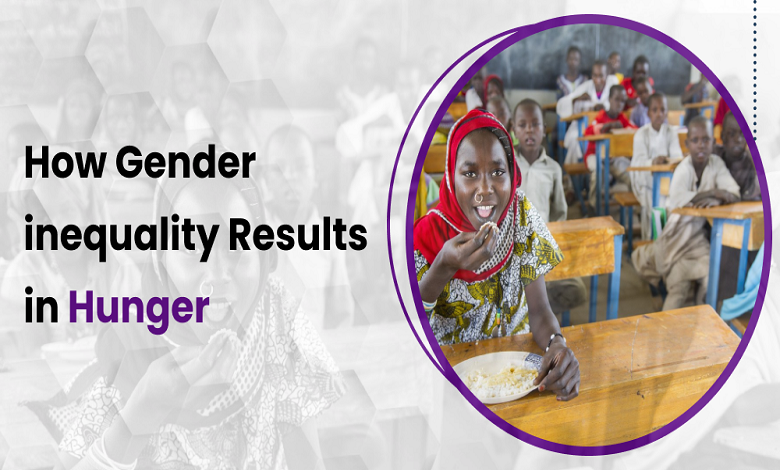How Gender inequality Results in Hunger

Even though women are nice, tough, brave, and empathetic, they nevertheless experience discrimination in many parts of their lives. Women suffer from hunger at a disproportionate rate around the world as a result of the historical imprint left by a lack of women’s rights, and deep-rooted gender stereotypes.
In comparison to men, women are more likely to live in poverty around the world. Food insecurity affects roughly 690 million people worldwide, with women accounting for 60% of those affected.
Before the pandemic, approximately 13.7 million American households lacked appropriate food access. In 2019, 28.7% of households with children with single mothers experienced food insecurity. Only 15.4% of single fathers experienced food insecurity. Here the gender inequality comes in, female suppress their needs while fulfilling others.
It’s no secret that women have fewer resources and face greater economic challenges than their male colleagues around the world. Many individuals are ignorant of why hunger disparities exist between men and women in one of the world’s wealthiest countries.
Gender discrimination in pay, racial disparity, maternity challenges, care obligations, lack of support during COVID-19. gender-based violence and insufficient federal nutrition programs are all factors that contribute to the gendered hunger gap all over the world.
Inequality & Covid-19
The pandemic has had a detrimental mental, physical, and financial impact on everyone, but it has been particularly bad for some populations. COVID-19 has a greater economic impact on women than it does on men, because of existing gender inequities. Women of color, on the other hand, are disproportionately affected by the economic downturn, with claims of lost income, jobs, and food security.
Reports of food insecurity as a result of COVID-19 underscore this heinous injustice. According to the National Women’s Law Center, a Washington, D.C.-based NGO, 57.1 percent of Hispanic women and 53 percent of Black women have claimed a loss of income since the pandemic began. In comparison, only 41% of white men and women reported lost wages during the pandemic. According to the study, more than 16% of Black and Hispanic women would face food insecurity in 2020, which is more than double the proportion of white women.
Pay gap
The pay disparity between men and women can be measured in two ways. The first is the ‘uncontrolled’ gender pay gap, which looks at the median compensation for men and women across all job types and positions. A man and a woman working in the same employment in the same position can also be compared to compute the ‘controlled’ wage disparity.
In the United States, the median wage for men is 19 percent greater than the median wage for women. Despite being an improvement over the past, it is still far from equal. When men and women with similar professional abilities and employment are compared, women still earn $0.98 for every dollar earned by men. This 2% pay cut adds up to thousands of dollars wasted over multiple years, with no explanation for why the wage difference persists.
Women are twice as likely as men to work in low-wage, part-time employment with few or no benefits in the United States. Many women, especially single mothers, do not have adequate health insurance or access to primary medical care. If sick leave is not provided, women risk losing their basic income or perhaps their jobs due to a lack of medical treatment. Women and their families need excellent work opportunities with equitable, reasonable earnings and adequate employment benefits to effectively combat hunger. There are many Catholic charities to donate to that helps such women and their children.
Violence
Food insecurity and violence are two key public health challenges that women in the United States experience. Violence against women and girls is one of the most common human rights abuses in the world. Gender-based violence respects no race, religion, state, or country boundaries; it affects women all around the world.
One out of every three women has experienced gender-based violence at some point in their lives. The frequency with which this type of abuse occurs is astounding. Around the world, 35% of women have been victims of physical or sexual violence. In addition, 7% of women have been sexually attacked by someone who is not their boyfriend. A 2019 study looked into the link between gender-based violence and food insecurity and discovered that victims of sexual, physical, or psychological abuse were more likely to report having very low food security. The social and economic implications of these acts of violence cause destruction to the survivors. Women and girls are more likely to experience food insecurity as a result of these salary and social network losses.
Insufficient programs
Food-insecure women and their families rely on federal nutrition programs. Young mothers who got assistance were less likely to suffer depression compared to others. Even though programs have helped millions of Americans get out of poverty, many people still lack the consistent nourishment they need to live an active, healthy lifestyle. The budget does not cover the costs of purchasing and preparing a healthful diet, then why don’t you help the poor in need.
Wrapping up
Maintain your knowledge of gender-based discrimination and how it impacts women today. Participate in and support organizations that address gender-based violence, racial inequities, and food insecurity in general. Many of these injustices against women are the result of a historically inequitable system. There is still a long way to go, despite the many advancements, but you can assist, and join our Catholic Community to help others.





